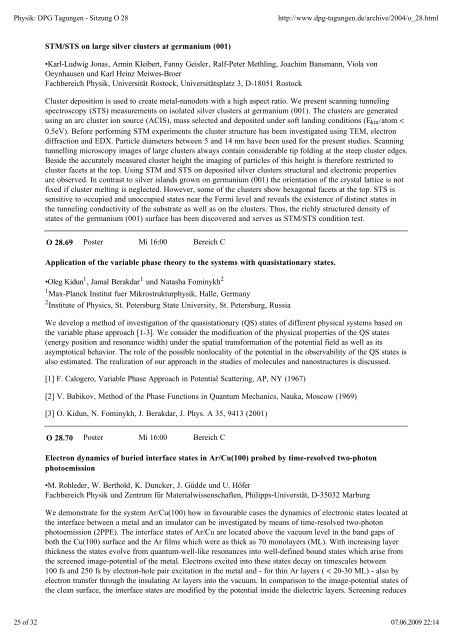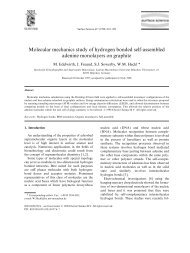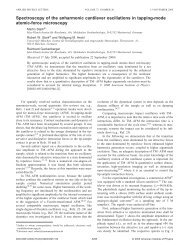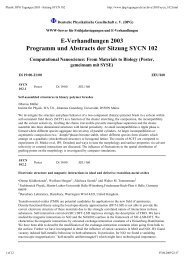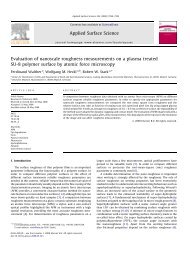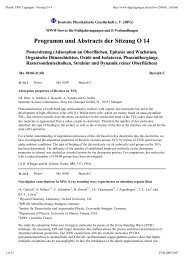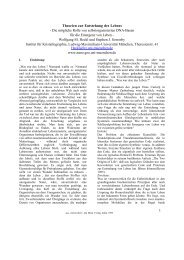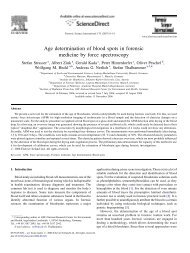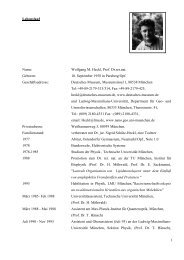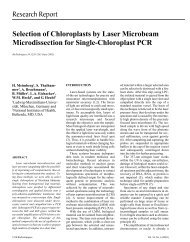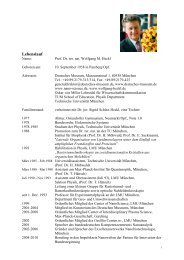Physik: DPG Tagungen - Sitzung O 28 - Nano-science.de
Physik: DPG Tagungen - Sitzung O 28 - Nano-science.de
Physik: DPG Tagungen - Sitzung O 28 - Nano-science.de
You also want an ePaper? Increase the reach of your titles
YUMPU automatically turns print PDFs into web optimized ePapers that Google loves.
<strong>Physik</strong>: <strong>DPG</strong> <strong>Tagungen</strong> - <strong>Sitzung</strong> O <strong>28</strong><br />
http://www.dpg-tagungen.<strong>de</strong>/archive/2004/o_<strong>28</strong>.html<br />
STM/STS on large silver clusters at germanium (001)<br />
•Karl-Ludwig Jonas, Armin Kleibert, Fanny Geisler, Ralf-Peter Methling, Joachim Bansmann, Viola von<br />
Oeynhausen und Karl Heinz Meiwes-Broer<br />
Fachbereich <strong>Physik</strong>, Universität Rostock, Universitätsplatz 3, D-18051 Rostock<br />
Cluster <strong>de</strong>position is used to create metal-nanodots with a high aspect ratio. We present scanning tunneling<br />
spectroscopy (STS) measurements on isolated silver clusters at germanium (001). The clusters are generated<br />
using an arc cluster ion source (ACIS), mass selected and <strong>de</strong>posited un<strong>de</strong>r soft landing conditions (E kin /atom <<br />
0.5eV). Before performing STM experiments the cluster structure has been investigated using TEM, electron<br />
diffraction and EDX. Particle diameters between 5 and 14 nm have been used for the present studies. Scanning<br />
tunnelling microscopy images of large clusters always contain consi<strong>de</strong>rable tip folding at the steep cluster edges.<br />
Besi<strong>de</strong> the accurately measured cluster height the imaging of particles of this height is therefore restricted to<br />
cluster facets at the top. Using STM and STS on <strong>de</strong>posited silver clusters structural and electronic properties<br />
are observed. In contrast to silver islands grown on germanium (001) the orientation of the crystal lattice is not<br />
fixed if cluster melting is neglected. However, some of the clusters show hexagonal facets at the top. STS is<br />
sensitive to occupied and unoccupied states near the Fermi level and reveals the existence of distinct states in<br />
the tunneling conductivity of the substrate as well as on the clusters. Thus, the richly structured <strong>de</strong>nsity of<br />
states of the germanium (001) surface has been discovered and serves as STM/STS condition test.<br />
O <strong>28</strong>.69 Poster Mi 16:00 Bereich C<br />
Application of the variable phase theory to the systems with quasistationary states.<br />
•Oleg Kidun 1 , Jamal Berakdar 1 und Natasha Fominykh 2<br />
1 Max-Planck Institut fuer Mikrostrukturphysik, Halle, Germany<br />
2 Institute of Physics, St. Petersburg State University, St. Petersburg, Russia<br />
We <strong>de</strong>velop a method of investigation of the quasistationary (QS) states of different physical systems based on<br />
the variable phase approach [1-3]. We consi<strong>de</strong>r the modification of the physical properties of the QS states<br />
(energy position and resonance width) un<strong>de</strong>r the spatial transformation of the potential field as well as its<br />
asymptotical behavior. The role of the possible nonlocality of the potential in the observability of the QS states is<br />
also estimated. The realization of our approach in the studies of molecules and nanostructures is discussed.<br />
[1] F. Calogero, Variable Phase Approach in Potential Scattering, AP, NY (1967)<br />
[2] V. Babikov, Method of the Phase Functions in Quantum Mechanics, Nauka, Moscow (1969)<br />
[3] O. Kidun, N. Fominykh, J. Berakdar, J. Phys. A 35, 9413 (2001)<br />
O <strong>28</strong>.70 Poster Mi 16:00 Bereich C<br />
Electron dynamics of buried interface states in Ar/Cu(100) probed by time-resolved two-photon<br />
photoemission<br />
•M. Rohle<strong>de</strong>r, W. Berthold, K. Duncker, J. Güd<strong>de</strong> und U. Höfer<br />
Fachbereich <strong>Physik</strong> und Zentrum für Materialwissenschaften, Philipps-Universtät, D-35032 Marburg<br />
We <strong>de</strong>monstrate for the system Ar/Cu(100) how in favourable cases the dynamics of electronic states located at<br />
the interface between a metal and an insulator can be investigated by means of time-resolved two-photon<br />
photoemission (2PPE). The interface states of Ar/Cu are located above the vacuum level in the band gaps of<br />
both the Cu(100) surface and the Ar films which were as thick as 70 monolayers (ML). With increasing layer<br />
thickness the states evolve from quantum-well-like resonances into well-<strong>de</strong>fined bound states which arise from<br />
the screened image-potential of the metal. Electrons excited into these states <strong>de</strong>cay on timescales between<br />
100 fs and 250 fs by electron-hole pair excitation in the metal and - for thin Ar layers ( < 20-30 ML) - also by<br />
electron transfer through the insulating Ar layers into the vacuum. In comparison to the image-potential states of<br />
the clean surface, the interface states are modified by the potential insi<strong>de</strong> the dielectric layers. Screening reduces<br />
25 of 32 07.06.2009 22:14


